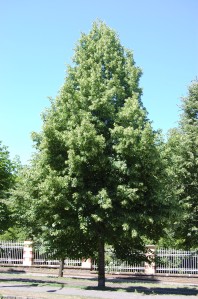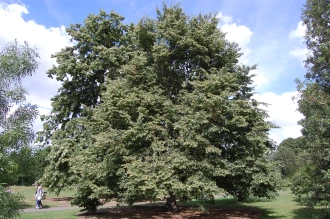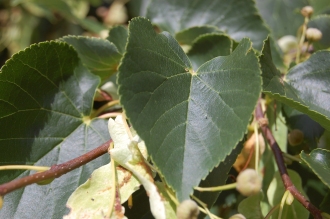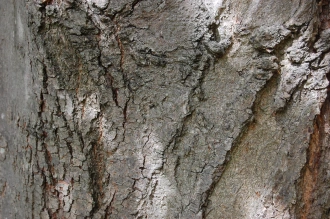Position: Full sun
Soil: Moist, well drained
Flowering period: Mid summer
Eventual Height: 30m
Eventual Spread: 12m
Hardiness: 4a, 4b, 5a, 5b, 6a, 6b, 7a, 7b, 8a, 8b, 9a
Family: Malvaceae
Tilia cordata is a deciduous tree with a spreading habit. Its foliage is rounded, chordate, glossy and dark green with serrate margins and are distinctively heart shaped. In early summer it bears small yellowish white hermaphrodite flowers in clusters of five to eleven with a leafy yellow green bract. The flowers have quite a heavy scent which are very attractive to bees. In autumn, following the flowers a dry drupes are formed.
Tilia cordata, commonly known as the Small-leaved Lime tree, Small-leaved Linden or Little-leaf Linden, is native to most of Europe including the UK. The flowers have been traditionally been used in traditional medicine in central Europe as an anti-inflammatory. This tree is the national tree of the Czech Republic and the Republic of Slovakia. This tree is one of the UK’s oldest native trees.
The etymological root of the binomial name Tilia is the ancient Latin name for the Lime tree. Cordata is derived from the Latin, referring to the cordate shape of the leaves.
The Landscape architect may find Tilia cordata useful as an excellent specimen tree. This tree has traditionally been planted in regular lines and avenues and is very suited to this purpose. Tilia cordata ‘Greenspire’ and Tilia cordata ‘Streetwise’ . This tree can be successfully pleached providing an unusual architectural living form.
Tilia cordata will tolerate many soil conditions; it will be happy in neutral or alkaline pH levels, in clay, sand or chalk but will require a sheltered location.
Ecologically, Tilia cordata will attract many pollinating insects such as honey bees.
The Royal Horticultural Society have given Tilia cordata their prestigious Award of Garden Merit.
Tilia cordata requires little maintenance. Dead or damaged material should be removed in spring.










Leave a comment